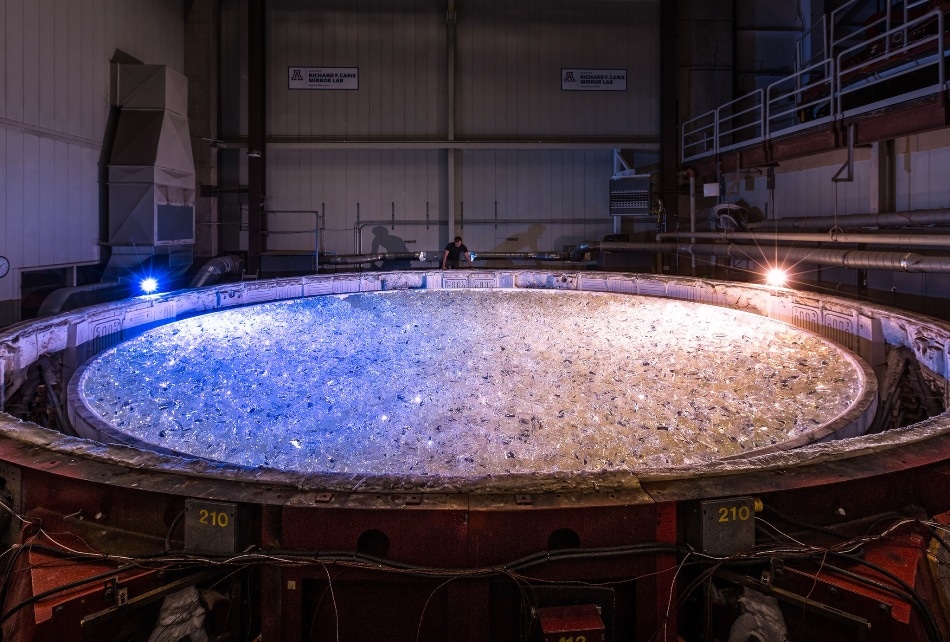Nov 6 2017
The Giant Magellan Telescope Organization (GMTO) has announced that it has started the casting of the fifth of seven mirrors that will form the center of the Giant Magellan Telescope (GMT).
Technicians have started casting the fifth mirror at the University of Arizona's Richard F. Caris Mirror Laboratory, the facility is well-known for developing the world's largest mirrors for astronomy. The GMT, measuring nearly 25 meters in diameter, will be located in the Chilean Andes and will be employed to study planets around other stars as well as to look back to the period when the first galaxies started to form. The process of "casting" the giant mirror includes melting nearly 20 tons of glass in a spinning furnace. The glass disk, once cooled, will be polished to its final shape using high-tech technology.
 The GMT mirror 5 mold filled with 17,500 kg of Ohara E6 low expansion glass, ready for the lid of the furnace to be placed. Credit: GMTO Corporation
The GMT mirror 5 mold filled with 17,500 kg of Ohara E6 low expansion glass, ready for the lid of the furnace to be placed. Credit: GMTO Corporation
The GMT will integrate the light from seven of these 8.4-meter mirrors in order to develop a telescope with an efficient aperture 24.5 meters in diameter (80 feet). Using this unique design, the GMT will generate images that are 10 times sharper compared to those from the Hubble Space Telescope in the infrared area of the spectrum.
Both Smithsonian Institution and Harvard University are members of the GMT project. Other members include the University of Chicago, the University of Arizona, Texas A&M University, the University of Texas at Austin, the São Paulo Research Foundation, the Korea Astronomy and Space Science Institute, the Carnegie Institution for Science, the Australian National University, and Astronomy Australia Ltd. The GMT primary mirrors are made at the Steward Observatory Mirror Lab at the University of Arizona (UA) in Tucson.
We are thrilled to be casting the Giant Magellan Telescope's fifth mirror, the Giant Magellan Telescope project will enable breakthrough discoveries in astronomy, and perhaps entirely new fields of study. With the talents of the team at the University of Arizona and across our entire community, we are taking the next step towards completing the seven-mirror GMT.
Dr. Robert N. Shelton, President of GMTO.
Each light-weighted mirrors of the GMT is a marvel of engineering. The mirrors start as pristine blocks of custom-made low-expansion E6 glass from the Ohara Corporation of Japan. These glass blocks, weighing precisely 17,481 kg, have been placed by hand into a custom-made furnace pre-loaded with a hexagonal mold. At the peak of the long casting process, where the huge furnace spins at up to five revolutions per minute, the glass gets heated up to 1165 °C (2129 °F) for about four hours until it dissolves and flows into the mold. The casting process goes on as the glass is cooled carefully for three months while the furnace spins at a slower rate. After that, the glass undergoes an extended period of polishing and shaping. The outcome of this high-precision process is a mirror polished to an accuracy of one twentieth of a light wavelength, or below thousandth of the width of a human hair.
Casting the mirrors for the Giant Magellan Telescope is a huge undertaking, and we are very proud of the UA's leading role creating this new resource for scientific discovery. The GMT partnership and Caris Mirror Lab are outstanding examples of how we can tackle complex challenges with innovative solutions, the University of Arizona has such an amazing tradition of excellence in space exploration, and I have been constantly impressed by the things our faculty, staff, and students in astronomy and space sciences can accomplish.
Robert C. Robbins, UA President
With its casting during the weekend, the fifth GMT mirror joins three other GMT mirrors at different stages of production in the Mirror Lab. Polishing of the second mirror’s front surface is well underway; coarse grinding will start on the front of the third mirror soon and the fourth mirror, the central mirror, will soon be ready for coarse grinding after the third mirror. The first GMT mirror was completed many years ago and was moved this September to a storage location in Tucson, awaiting the next phase of its journey to Chile. The sixth mirror’s glass has been delivered to Tucson and the seventh mirror’s glass is on order from Japan’s Ohara factory.
Eventually, the giant mirrors will be moved to GMT’s future home in the Chilean Andes at the Las Campanas Observatory at the Carnegie Institution for Science. This location is known for being one of the best astronomical locations on the planet with its clear, dark skies and steady airflow producing extremely sharp images. GMTO has started construction in Chile and has developed the infrastructure on the location needed to support construction activities.
Creating the largest telescope in history is a monumental endeavor, and the GMT will be among the largest privately-funded scientific initiatives to date, with this next milestone, and with the leadership, technical, financial and scientific prowess of the members of the GMTO partnership, we continue on the path to the completion of this great observatory.
Taft Armandroff, Professor of Astronomy and Director of the McDonald Observatory at The University of Texas at Austin, and Vice-Chair of the GMTO Corporation Board of Directors.